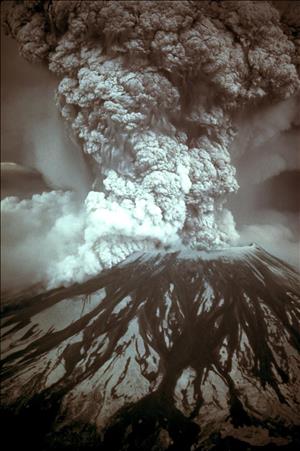On August 26, 1982, President Ronald Reagan signs into law the Mount St. Helens National Volcanic Monument Act. Along with several cosponsors, U.S. Representative Don Bonker, a Democrat who represents the 3rd Congressional District where Mount St. Helens stands, guides the bill through the House of Representatives, where it is approved by a 393-8 vote. A voice vote in the Senate carries. The law establishes a 110,000-acre national monument to be administered by the U.S. Forest Service to protect the area’s unique features for public education and scientific understanding. On October 23, 1998, another law will go into effect to consolidate and complete the monument.
From Devastation to Protection
The May 18, 1980, eruption of Mount St. Helens devastated the surrounding landscape, destroying millions of trees and almost all plant and animal life across almost 250 square miles. After focusing first on rescue missions and stabilizing risks to life, property, and infrastructure, interested parties turned to the bleak landscape. Scientists and land managers saw an opportunity to dedicate the landscape to scientific inquiry. Many scientists had grown alarmed by the Soil Conservation Service artificially seeding some of the area with nonnative species in August 1980. Protection from such ill-conceived plans rallied them toward protecting the post-eruption landscape from excessive human influence.
Almost immediately after the May 1980 eruption, federal land managers recognized the area needed special protection. The Region Six office of the Forest Service based in Portland considered eight options. None of them planned for major rehabilitation work. Instead, they allowed natural processes to proceed unimpeded. Officials expected recovery to be slower without artificial planting of trees, and they wanted to watch ecological processes unfold without human interference. Because the agency planned for intensive scientific research, it did not seek wilderness designation, which might have prevented the sort of access deemed necessary. The Forest Service identified roughly 85,000 acres for this initial interpretive area on October 16, 1981. Its focus was education, research, and recreation, although some timber salvage in the most damaged areas was permitted. A group of local conservationists called for a much larger area, 200,000 acres, to be protected.
In 1982, Congress stepped in with a bill to convert the land to a national volcanic monument. All members of Washington’s delegation supported and cosponsored the bill. Don Bonker (1937-2023), a Democratic congressman from the 3rd District, was the primary sponsor. It passed the House of Representatives in an overwhelming 393-8 vote and an easy voice vote in the Senate. President Ronald Reagan signed it into law by late summer 1982. None of this would have been possible without scientists advocating for this special place.
Because the Mount St. Helens National Volcanic Monument was carved out of the Gifford Pinchot National Forest, the Forest Service would remain the lead agency. The monument became a distinct unit within the national forest. According to the legislation, the primary purpose was to "protect the geologic, ecologic, and cultural resources" to allow "geologic forces and ecological succession to continue substantially unimpeded." In addition, managers would "prevent undue modification of the natural conditions of the Monument" (Public Law 97-243, 305).
To be sure, visitors were encouraged, but the monument’s mission mainly focused on studying and teaching about ecological processes. The new monument sat among other protected landscapes – national parks and designated wilderness – where extraction and commercial development were disallowed. The monument was unique in the U.S. public land system with this opportunity to observe ecological succession at such a scale.
Land Exchanges
Although its purpose was central to the legislation, most of the law focused on acquiring private land held within the boundaries of the 110,000-acre monument. A legacy of nineteenth-century railroad land grants and the sale of those parcels to private timber companies meant that about 32,000 acres within the Gifford Pinchot National Forest still were owned by corporations, mainly Burlington Northern Incorporated and the Weyerhaeuser Company. To consolidate management and administration of the new monument, Congress provided for acquiring these lands by exchange, donation, or purchase. The secretary of agriculture had 90 days to complete the transactions.
Acquiring land proved relatively easy. Obtaining mineral rights took longer. In 1998, Congress passed another bill, the Mount St. Helens National Volcanic Monument Completion Act, to finish the work. This law directed the secretary of interior, whose jurisdiction included mineral rights on federal lands, to exchange mineral and geothermal interest within the monument boundaries. Through transfer, sale, or issuing credits, the secretary had 60 days to complete these transactions and the monument.
Since it opened, scientists have continued to study the volcano and evolution of the surrounding ecosystems. Public visitors go to observatories, visitor centers, and overlooks to see the devastation and recovery firsthand. More than a million visitors every year take time to observe and learn in this protected, always-changing landscape.

